
Vlad Yudkin
March 26, 2024
Fitness SEO: How to Attract More Clients
Seeking methods to attract additional clientele to your fitness center or gym? Here, we'll outline effective strategies to help you achieve the goal.
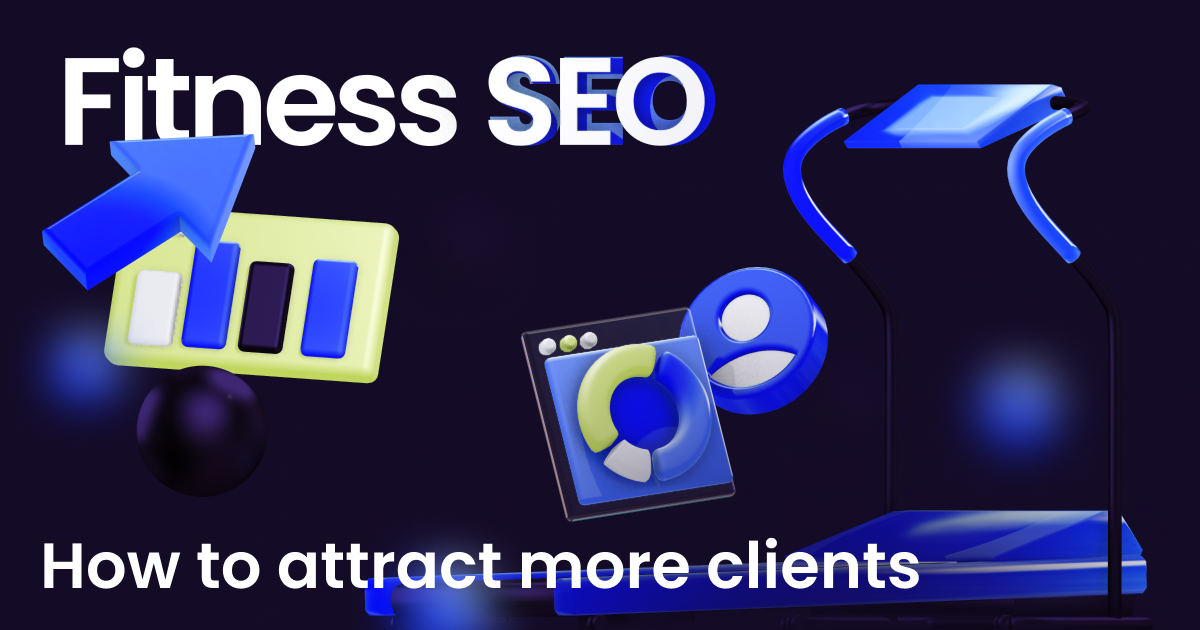
What is SEO For Gyms and Fitness Centers?
SEO for gyms and fitness centers involves optimizing your page or website and working on online presence to improve visibility in Google results when potential clients search for relevant keywords or phrases related to fitness, workouts, or gym services. The goal is to rank higher in SERPs to attract more organic and efficient traffic to your website and ultimately increase membership sign-ups or inquiries.
Why Do You Need SEO for Fitness Centers and Gyms
In the highly competitive niche of fitness centers and gyms, where numerous establishments vie for the attention of potential clients, having a robust online presence is paramount. With a plethora of options available, winning the competition for clients requires more than just offering quality services; it demands strategic marketing efforts.

By ensuring that your website and social media profiles are SEO optimized, you position your fitness center or gym for success in the digital arena. SEO optimization enhances your visibility in Google, making it easier for prospective clients to discover and engage with your business. Moreover, a strong social media presence further amplifies your reach, allowing you to connect with audiences and cultivate a loyal community around your fitness brand. In this fiercely contested landscape, effective SEO optimization is the key to standing out amidst the crowd and attracting clientele to your fitness establishment.
Let’s highlight the reasons why SEO can benefit your gym:
- Increased Online Visibility. The industry is highly competitive, with numerous gyms and fitness centers vying for the attention of potential clients. SEO helps your business stand out by improving its visibility in SERPs. When people search for fitness-related terms or local gyms, a strong SEO strategy ensures that your website appears prominently, increasing your chances of attracting lots of clicks and inquiries.
- Targeted Traffic. SEO enables you to focus on particular keywords and phrases that are pertinent. By optimizing your pages for these keywords, you can get highly targeted to your niche traffic consisting of individuals actively seeking for different services. This targeted approach increases the chances of converting casual website visitors into actual clients or members.
- Builds Credibility and Trust. Ranking well in search engine results instills trust and credibility in potential clients. People tend to trust websites that appear in the first few results of Google, viewing them as reputable and authoritative sources. Effective SEO signals to prospective clients that your fitness center or gym is established, reliable, and worthy of consideration.
- Cost-Effective Marketing. SEO offers a cost-effective strategy. Once your site is greatly optimized and ranking pretty well, you can attract organic traffic without incurring ongoing expenses for each visitor. Over time, this can lead to significant cost savings while still driving a steady stream of leads and inquiries.
- Competitive Advantage. If your competitors are investing in SEO and outranking you in search results, they're likely capturing a significant portion of potential clients. By implementing SEO strategies effectively, you can level the playing field and even surpass competitors, attracting more clients to your fitness center or gym.
- Local SEO Search Optimization. Many individuals search for fitness centers or gyms in their local area. Local SEO tactics, such as optimizing your gym’s or fitness center’s Google My Business profile and using location-based keywords on your website, help your business appear in search results that are related to certain locations. This increases visibility among potential clients who are actively seeking options nearby, driving foot traffic and inquiries to your establishment.
7 SEO Tips to Boost Your Fitness Gym’s Website
SEO presents an excellent opportunity to garner organic traffic and attract new clients. However, navigating its intricacies might seem daunting. We're here to navigate you through the most effective tips to kick-start your local SEO journey and propel your business forward.
Google My Business
Google My Business is a crucial asset for any fitness center or gym looking to bolster its online presence and attract more clients. With this strong tool, you make sure that all your important business information is accurately displayed to potential customers when they search for fitness facilities in your area. This includes essential details such as your gym's location, contact information, operating hours, and even photos of your facility and amenities. GMB is important for a good SEO strategy.
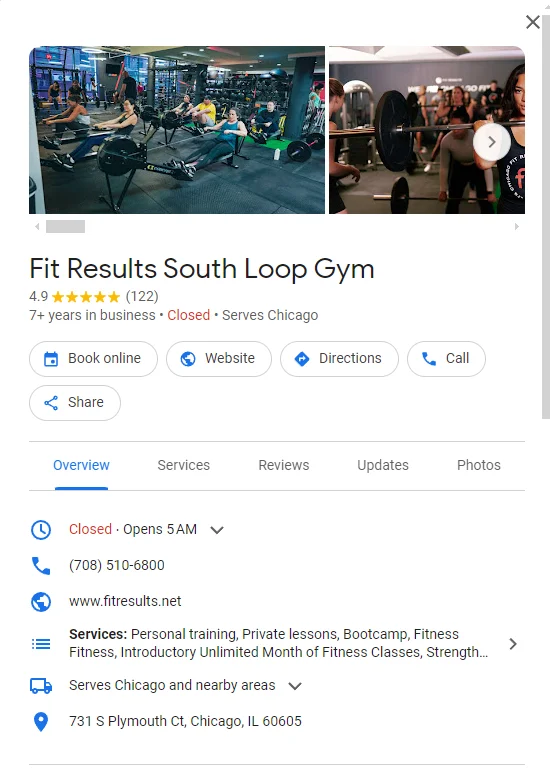
A well-optimized profile in GMB not only enhances your visibility but also builds trust and credibility among potential clients. Additionally, Google My Business provides a platform for customers to leave reviews and ratings, which can further influence others' decisions to choose your gym over competitors.
To effectively fill out your Google My Business (GMB) profile, start by claiming your listing and ensuring all essential information is accurate and up-to-date. Provide your gym's name, full address, correct phone number, and website URL. Add relevant categories to specify your business type, such as "Gym" or "Fitness Center." Include engaging photos of your facility, trainers, and equipment to give potential clients a glimpse of what to expect. Utilize the "Services" section to highlight the different classes, programs, or amenities your gym offers. Encourage satisfied members to leave positive and honest reviews and respond promptly to any customer inquiries or feedback. Regularly update your GMB profile with special promotions, events, or changes in operating hours to keep clients informed and engaged.
User the Right Keywords
Finding the right keywords for your SEO strategy involves a comprehensive approach that considers various factors to ensure maximum effectiveness. This is a big part of local SEO. Begin by brainstorming a list of terms related to your gym's services, facilities, location, and target audience. This can include general keywords like "fitness center," "gym," or "personal training," as well as more specific terms such as "yoga studio," "strength training," or "cardio classes."
Use different SEO keyword research tools that you can find to expand your list and identify additional keywords with high search volume than the other ones and low competition. Pay attention to long-tail keywords, they are usually longer and have more specific phrases that often indicate stronger user intent. For example, "best gym for weight loss in [City]" or "family-friendly fitness center with childcare."
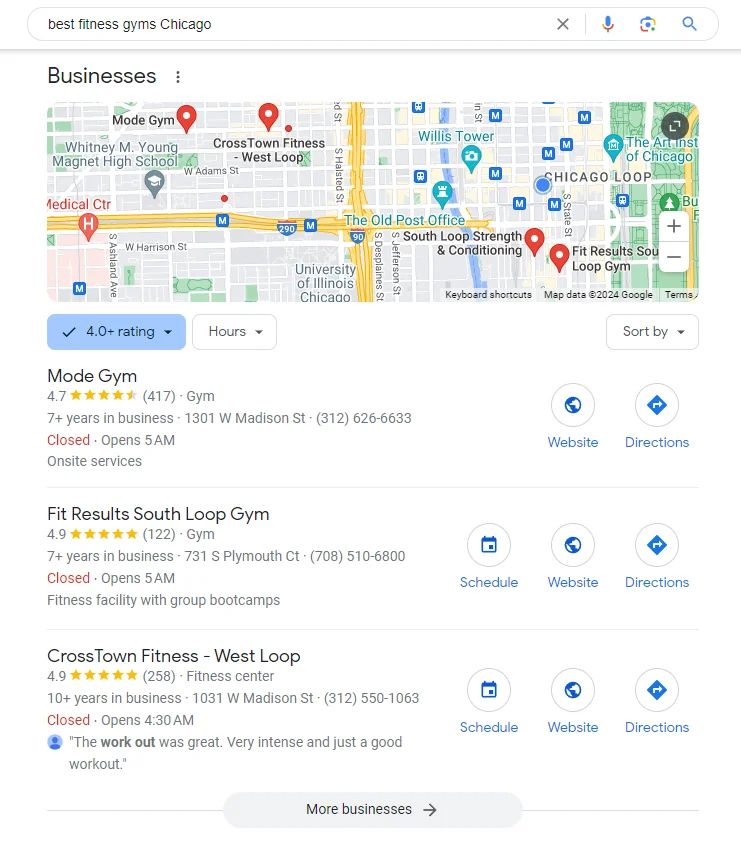
Consider the geographical location of your gym and include location-based keywords to target local audiences. This can include the name of your city, neighborhood, or nearby landmarks. For example, "fitness center in downtown [City]" or "gym near [Landmark]."
Analyzing competitor websites and examining their keyword strategies can also provide valuable insights into effective keywords for your fitness center or gym. Look for keywords that competitors are ranking for and consider incorporating similar terms into your own SEO strategy.
Consistently monitor and analyze the performance of the keywords you've selected. Adjust your keyword strategy based on performance metrics such as search volume, click-through rate, and conversion rate.
Optimize Your Pages
Optimizing the various elements of your center or gym's website pages is essential for improving visibility and, of course, user experience. Here's a more detailed breakdown of the most important things to optimize:
- Page Titles (H1). Use descriptive and relevant H1 titles that exactly show the meaning of your page. Include primary keywords related to your business, such as "Fitness Classes in [City]" or "Personal Training Services."
- Meta Descriptions. Create short but compelling descriptions that summarize the content of each page in a concise and engaging manner.
- Image Names. When naming images on your website, use descriptive and appropriate filenames that accurately reflect the content of the image. Instead of generic names like "image001.jpg," opt for descriptive filenames such as "yoga-class-group-training.jpg" or "cardio-equipment-gym.jpg."
- Image Alt Text. Alt text provides a text description of images for users who are visually impaired or for situations where images cannot be displayed. Include some of your SEO keywords in image alt text while providing a clear and accurate description of the image. For example, "Group fitness class doing yoga poses in the studio."
- Content Optimization. Ensure that the texts on each page of your website is well-written, informative, and optimized for relevant keys. Incorporate primary and secondary keywords naturally throughout your blog, including headings, paragraphs, and bullet points.
- Internal Linking. Use internal linking to connect related pages, helping Google figure out the structure and hierarchy of your site. Link to relevant pages using descriptive anchor text that includes keywords related to the linked page.
- Schema Markup. Incorporate a well-structured schema markup, such as LocalBusiness schema, to provide Google with additional and useful context. This can help improve your website's visibility in local results in Google and enhance the likelihood of appearing in featured snippets.
- Page Speed Optimization. Improve the loading speed of all your pages. A fast-loading site contributes to better rankings and, of course, lets users enjoy your content fully.
Remember About Mobile Users
Optimizing your fitness center or gym's website for mobile users is extremely important nowadays, where an increasing number of people access the internet via smartphones and tablets. Mobile optimization ensures that visitors can easily navigate and interact with your pages on smaller screens. This encourages engagement and conversions.
Start by implementing a responsive web design, which automatically adjusts the layout and content of your site to fit different screen sizes. This guarantees that your website maintains optimal appearance and functionality across a range of devices, spanning from smartphones and tablets to desktop computers. A responsive design eliminates the need for separate mobile and desktop versions of your site, simplifying maintenance and ensuring consistency across all platforms.
Prioritize speed and performance optimization to ensure fast loading times on mobile devices. Mobile users are often on the go and have little patience for websites that load even a bit slower, than usual. Optimizing images, minimizing server response times, and leveraging browser caching can help improve your page load speed.
UNHAPPY WITH YOUR WEBSITE PERFOMANCE?
Let's discuss your problemStreamline navigation and content for mobile users by prioritizing essential information and making it easily accessible. Consider using collapsible menus, clickable phone numbers, and clear calls-to-action to facilitate navigation and encourage conversions. Keep text concise and legible, and use large, touch-friendly buttons and links to make it easy for users to interact with your site on touchscreen devices.
Conduct comprehensive testing of your website on different devices and browsers to detect and resolve any usability issues or discrepancies. Regular testing and gathering feedback from mobile users can help you continually refine and improve the mobile experience for visitors of your fitness center or gym's site, ultimately driving more engagement, leads, and memberships.
Improve Backlinks
Backlinks play a crucial role in improving your gym's rankings, as Google considers them as one of the most important factors when determining the credibility and authority of a site. High-quality backlinks from famous and relevant websites in the industry can significantly boost your gym's online visibility and attract more traffic.
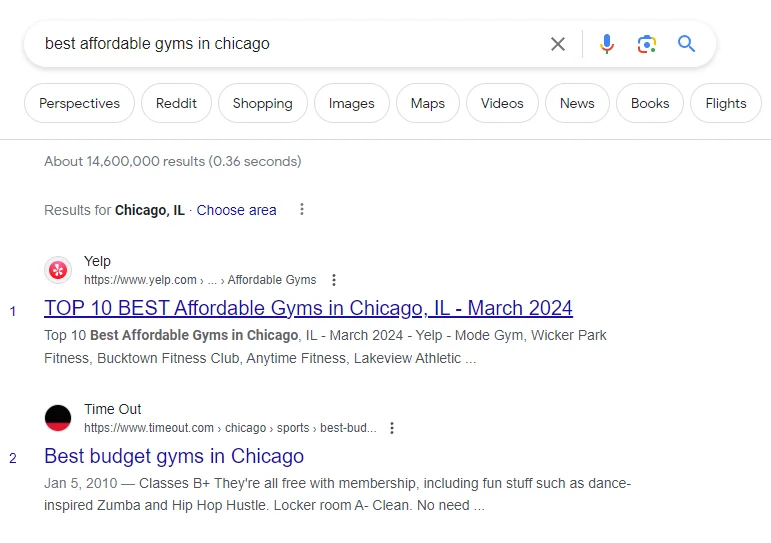
Backlinks provide opportunities for referral traffic, as users who click on these links are directed to your site, potentially leading to increased inquiries and memberships for your fitness center or gym.
Building a diverse and natural backlink profile through strategies such as content creation, outreach, and relationship building can help your gym establish itself as a reputable authority in the fitness industry and attract more clients.
Create Unique Content
Creating valuable content is essential for the success of your fitness center or gym's online presence. Unique content provides an opportunity to showcase your gym's expertise, personality, and offerings to potential clients. By sharing informative and engaging posts related to sports, health, nutrition, and workouts, you can establish your gym as a valuable resource and authority in the industry.
Unique information helps improve your gym's search engine visibility by targeting relevant keys and attracting interested users to your website. It also encourages social sharing and engagement, as users are more likely to share content that resonates with them, thereby increasing your gym's reach and visibility on social media platforms.
Don’t Underestimate Social Media
Underestimating the power of social media for SEO in promoting your company could be a significant missed opportunity. Social media platforms serve as valuable channels for increasing your gym's online visibility and improving rankings in Google. By actively engaging with your audience on platforms like Facebook, Instagram, and Twitter, you can foster a community around your gym, share valuable content, and promote your services to a wider audience.
Social media activity can generate social signals that indicate to search engines the relevance and popularity of your gym's website, potentially leading to improved search rankings. Furthermore, social media platforms often appear in SERPs, providing another avenue for potential clients to discover your gym. Thats very important for a good SEO strategy.
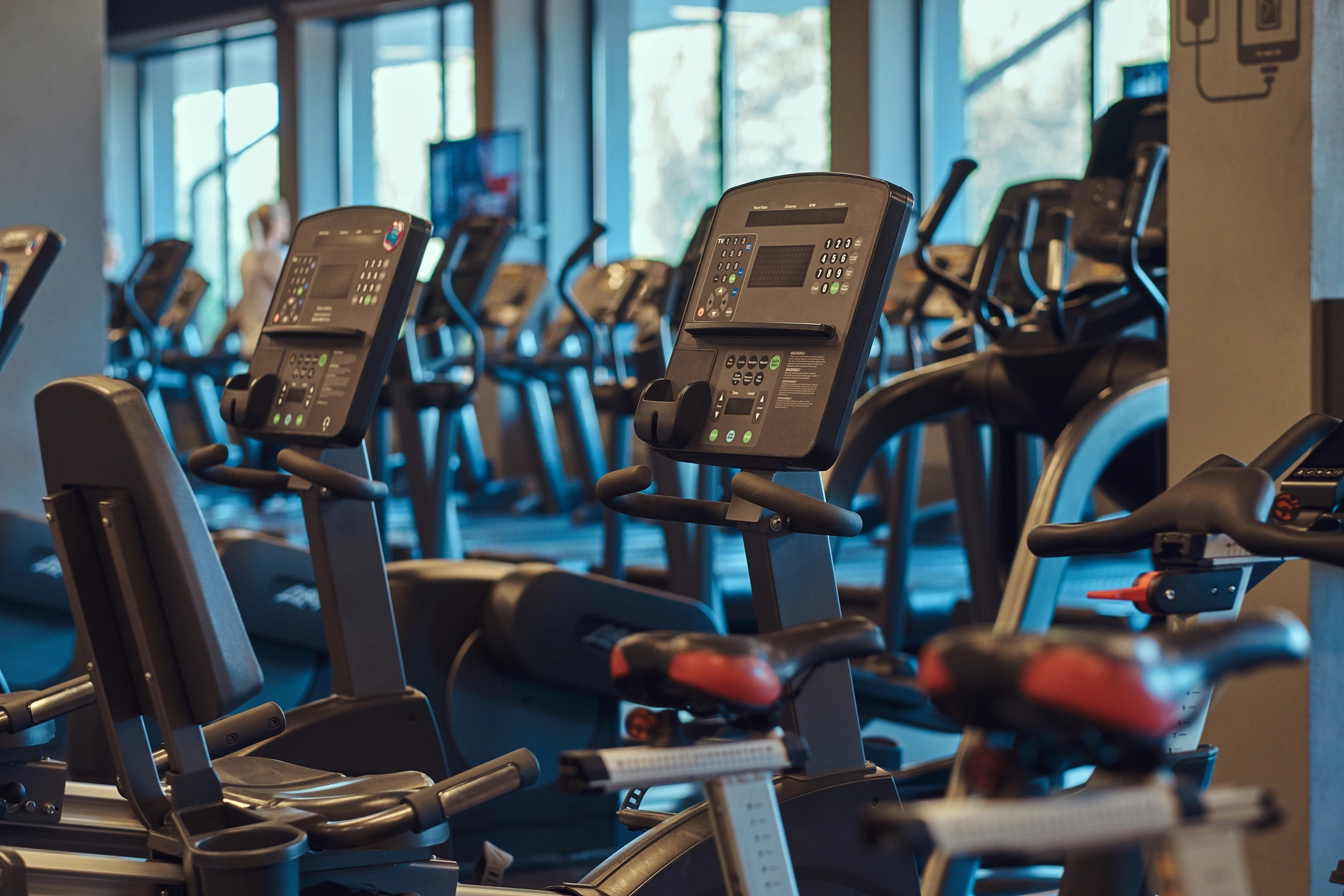
Conclusion
SEO stands as a powerful tool for boosting the visibility, credibility, and success of fitness centers and gyms. By implementing effective and creative SEO strategies tailored to the specific needs of fitness businesses, such as local SEO, keyword optimization, and content creation, gyms can improve or increase their online presence, gain more targeted traffic, and convert leads into loyal clients. From optimizing website pages to leveraging social media and local citations, every aspect of SEO contributes to expanding a gym's reach and impact within its community.
Faq
Will SEO help online fitness websites or is it only for offline businesses?
SEO is beneficial for both online fitness websites and offline businesses with an online presence (which you definitely need). In fact, SEO is particularly crucial for online fitness websites as it helps them improve their visibility in Google, attract new users, and increase their chances of converting part of the visitors into customers. By optimizing their website content, using relevant keywords, and implementing other SEO techniques, online fitness websites can enhance their online presence, compete effectively in the digital space, and ultimately drive growth and success.
SEO can be equally valuable for offline fitness businesses that have an online presence, such as gyms or fitness centers, as it helps them attract local customers, increase brand awareness, and drive foot traffic to their physical locations.
Is SEO a one-time investment or an ongoing process?
Search engine algorithms are constantly evolving, and new competitors continually enter the market, making it essential for businesses to continuously adapt and refine their SEO strategies to remain competitive. While initial efforts such as keyword research, website optimization, and content creation lay the foundation for SEO success, ongoing activities such as monitoring performance metrics, updating content, building backlinks, and staying abreast of algorithm changes are necessary to maintain and improve rankings over time.
As consumer behaviors and search patterns evolve, businesses must adjust their SEO tactics accordingly to ensure continued relevance and effectiveness in attracting targeted traffic and achieving business goals. Therefore, viewing SEO as an ongoing process rather than a one-time investment is crucial for long-term success in the digital landscape.





